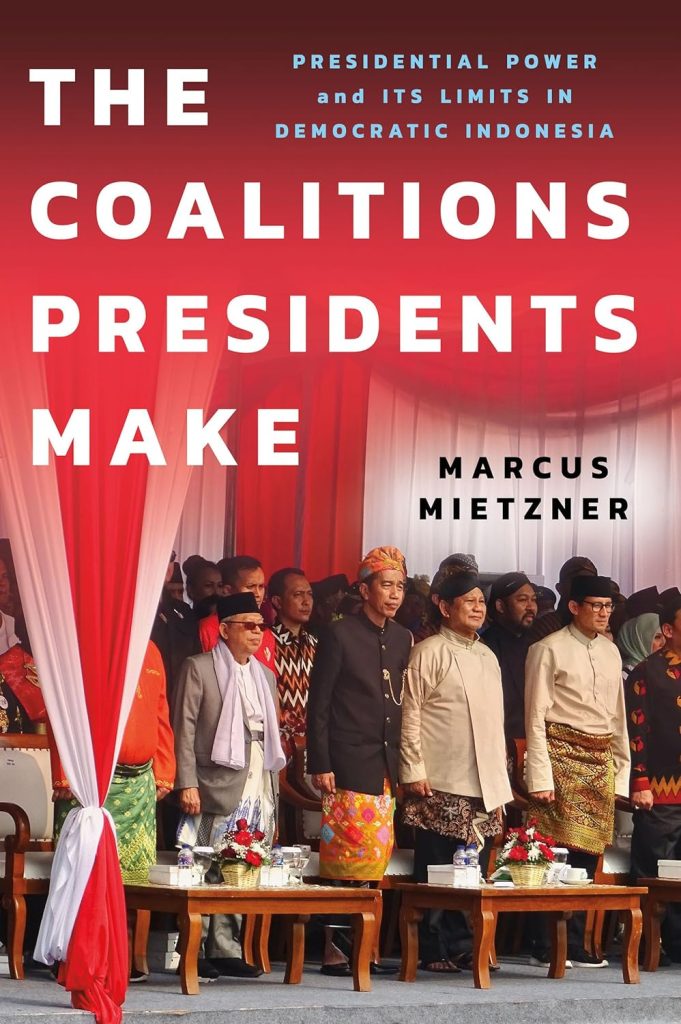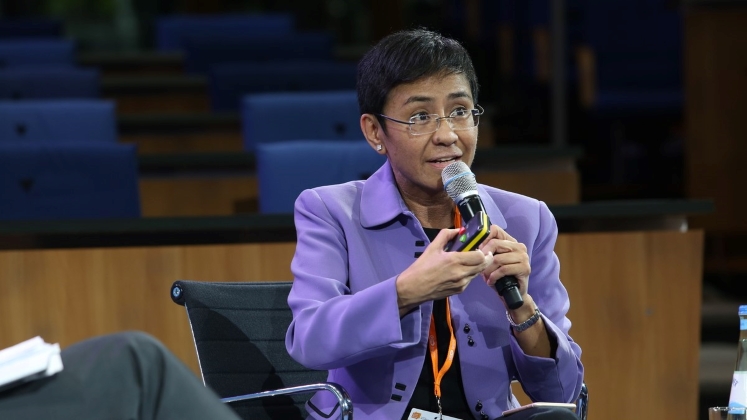Marcus Mietzner‘s The Coalitions Presidents Make examines Indonesia’s political transition, focusing on power-sharing arrangements and their impact on democratic reforms post-2004. Drawing on extensive qualitative data, Mietzner both sheds light on Indonesia’s particular case and reflects more broadly on coalition politics in emerging democracies, writes Yen Nie Yong. This post was originally published on the LSE Southeast Asia Blog.
 The Coalitions Presidents Make is a welcome contribution to the analysis of the processes of political change in the emerging economies of East Asia and Southeast Asia, especially in light of Indonesia’s recent parliamentary and presidential elections.
The Coalitions Presidents Make is a welcome contribution to the analysis of the processes of political change in the emerging economies of East Asia and Southeast Asia, especially in light of Indonesia’s recent parliamentary and presidential elections.
Post-Suharto Indonesia is often portrayed as an era that ushered in the birth of a new presidential democracy in the country. However, the transition from a decades-old strongman regime – specifically one that bookmarks the turbulent period of postcolonial social and economic development and Suharto’s fall – was messy and remains incomplete. It is from this incompleteness that Mietzner began his comprehensive study on the coalition presidentialism of Indonesia from the year 2004 to its current state.
Mietzner utilis[es] data from over 100 qualitative interviews with not only the former and current presidents of Indonesia, but also various actors who are directly and indirectly involved in the process of coalition-building.
This monograph is aimed at readers familiar with the literature of coalition presidentialism within the field of Political Science and Indonesian Studies. However, as a researcher who primarily focuses on Malaysian companies in the postcolonial era, I found this book to be a page-turner, largely due to Mietzner’s adept narrative-building skills throughout the book. This is hardly surprising, as Mietzner offers details gleaned from more than two decades of observing the country’s democratic transition from a close-up view. Mietzner’s approach is also ethnographic, by utilising data from over 100 qualitative interviews with not only the former and current presidents of Indonesia, but also various actors who are directly and indirectly involved in the process of coalition-building. The amount of qualitative data accumulated is commendable, as access to the presidents’ inner circle generally requires years of effort in relationship-building, as well as the researcher’s discernment in knowing the difference between the true internal workings and smokescreens of Indonesia’s politics.
How have Indonesia’s presidents post-2004 managed to survive the perils of presidentialism, and what is the price for it?
Mietzner’s key research questions are fascinating – how have Indonesia’s presidents post-2004 managed to survive the perils of presidentialism, and what is the price for it? Indonesia, he argues, achieved more success in transitioning from an unstable presidential regime in the early post-Suharto period into a democracy that is among the world’s most resilient. This is mainly because of the informal coalitions with non-party actors who enjoy or covet political privileges such as the military, the police, oligarchs and religious groups. These actors require as much courting and co-opting as political parties and legislators, a key finding which current studies have ignored or downplayed. In each chapter, Mietzner explains the collective power of a political actor, and utilises a case study to link the phenomenon with his analysis, which I found to be compelling and clear. The locked-in stability created by the broad coalitions under Yudhoyono’s and Widodo’s presidency, nevertheless, had dire consequences in terms of stagnating reforms and democratic decline. Mietzner argues that Indonesia is a prime example of this phenomenon and ought to be a valuable lesson to be studied by those interested in presidential democracies globally.
Through reading this book, my impression is that the power-sharing arrangements between the president and his diverse coalition partners are akin to a prisoner’s dilemma. Mietzner argues that the incumbent president and his predecessor opted for this particular kind of accommodation because of perceived and imagined fears of what might happen to them if they were to choose the path of taking down these coalition partners. The coalition partners also appear to have taken a similarly defensive stance, thus perpetuating existing political arrangements among the actors at the expense of democratic reforms. This, Mietzner explains, is grounded in history, as both sides remain committed to upholding the image of the Indonesian presidency as the key provider of political stability. Many of the politicians and coalition partners lived through the Suharto years and learned how to “do politics” during that era, thus internalizing the appeal of working with presidents in power rather than working to overthrow them.
One element which Mietzner could have expanded upon in the book is how […] historical pathways have impacted on the current accommodation style between the president and non-party actors.
One element which Mietzner could have expanded upon in the book is how these historical pathways have impacted on the current accommodation style between the president and non-party actors. The relationship between the president and the oligarchs is particularly instructive in this regard, as Mietzner shows that in post-2004 coalitions, the oligarchs’ participation in coalition politics became “more direct, formal and institutionalized” (194). What happened during the transition years post-1998 that had enabled the oligarchs such access which was not available to them before? This context can help clarify if the pre-1998 accommodation between the president and capitalists were thoroughly dismantled, and if so, led to expansion of coalitions to other non-party actors after 2004. As history has shown, past strongman leaders in Asia (especially those who fought against colonialism) do not fade easily. The nostalgia for Suharto’s rule was also highlighted by the media during the 2014 presidential elections, elucidating how historical baggage constrains presidents from embarking on meaningful political reforms in this country.
The Indonesian case is an ideal one to expand conceptual boundaries in comparative studies of coalition presidentialism.
Does the specific context of Indonesia’s coalition presidentialism make this case an outlier and thus inapplicable to other democracies? Mietzner emphasises that the Indonesian case is an ideal one to expand conceptual boundaries in comparative studies of coalition presidentialism. As the bulwark of democracy in Southeast Asia, perhaps Indonesia may offer valuable insights beyond coalition presidentialism. As a novice reader on the conceptual theories of coalition presidentialism, I am also curious about whether this can also be relevant to other democracies in Southeast Asia, especially in the context of their shared postcoloniality. After all, the multiplicity of non-party actors in Indonesia’s context should also be situated in the diverse cultural identities of these actors and the postcolonial unsettledness of the nation’s identity. In his proclamation of Independence in 1945, Sukarno had famously used the acronym “d.l.l., or etc. in the Bahasa, which author and former journalist Elizabeth Pisani highlighted in her book Indonesia Etc: Exploring the Improbable Nation.
In Mietzner’s concluding chapter, he writes, “the more pressing challenge is to explore how coalitional presidentialism can work without sucking the oxygen out of democratic societies (245).” This is a conspicuous issue confronting not only Indonesia, but also its neighbouring democracies in the region. The revolving door of party and non-party actors in Indonesia highlights the precarious nature of the development of civil society in Southeast Asia. One can also see the parallels drawn in Malaysia’s coalition party politics, its longstanding stability, and the inclusion and exclusion of civic groups that have undermined the nation’s political progress for decades.
In this sense, Mietzner’s analysis of Indonesia’s coalition presidentialism is highly relevant for future research, as it presses upon researchers the important message to continue to investigate the undercurrents of other young, evolving and often fragile democracies in recent years.
Note: This book review is published by the LSE Southeast Asia blog and LSE Review of Books blog as part of a collaborative series focusing on timely and important social science books from and about Southeast Asia.
The review gives the views of the author, and not the position of the LSE Review of Books blog, or of the London School of Economics and Political Science.
Image: Joko Widodo, the President of Indonesia
Image credit: Ardikta on Shutterstock.







